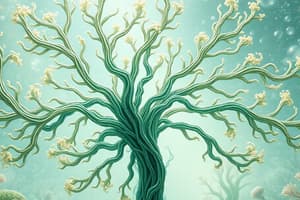Podcast
Questions and Answers
What type of algae is known for its large, multicellular marine species commonly called seaweeds?
What type of algae is known for its large, multicellular marine species commonly called seaweeds?
- Brown algae (correct)
- Green algae
- Cyanobacteria
- Red algae
Which pigment is responsible for the red color of red algae and allows them to photosynthesize at greater depths?
Which pigment is responsible for the red color of red algae and allows them to photosynthesize at greater depths?
- Fucoxanthin
- Phycoerythrin (correct)
- Chlorophyll a
- Phycocyanin
What is the term for the gelatinous material found in the cell walls of brown algae?
What is the term for the gelatinous material found in the cell walls of brown algae?
- Carrageenan
- Agar
- Cellulose
- Algin (correct)
Which type of algae has spiral or helical chloroplasts?
Which type of algae has spiral or helical chloroplasts?
What is the term for the process by which some algae can switch between autotrophic and heterotrophic modes of nutrition?
What is the term for the process by which some algae can switch between autotrophic and heterotrophic modes of nutrition?
Which group of algae is characterized by the presence of two flagella, one of which is typically wrapped around the cell body?
Which group of algae is characterized by the presence of two flagella, one of which is typically wrapped around the cell body?
Flashcards are hidden until you start studying
Study Notes
Types of Algae
- Brown algae is known for its large, multicellular marine species commonly called seaweeds.
- Red algae gets its distinctive color from the pigment phycoerythrin, which allows them to photosynthesize at greater depths.
- Green algae is known for its spiral or helical chloroplasts, as seen in Spirogyra.
Structures of Algae
- Rhizoid is not a root-like structure, but rather a holdfast anchors some seaweeds to rocks.
- Stipe is a structure found in some seaweeds, but it's not the root-like structure.
- Blade is a structure found in some seaweeds, but it's not the root-like structure.
- Algin is the gelatinous material found in the cell walls of brown algae.
Movement and Nutrition
- Dinoflagellates are a group of algae that can move using flagella.
- Mixotrophy is the process by which some algae can switch between autotrophic and heterotrophic modes of nutrition.
Other Facts
- Chlamydomonas nivalis is a type of algae that can be found in snow, giving it a pink or red hue, and is known as “snow algae”.
- Stigma is the eye-like structure that detects light in some motile algae.
- Euglenoids are a group of algae characterized by the presence of two flagella, one of which is typically wrapped around the cell body.
Studying That Suits You
Use AI to generate personalized quizzes and flashcards to suit your learning preferences.




